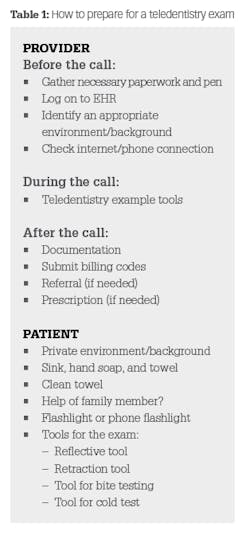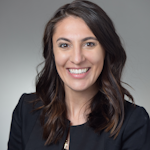Do you ever reflect back on your career and think, “I can’t believe that I am doing (insert newest technology or way of practice)”? I don’t know where I picked up this line of thinking, but I often consider this. Dentistry is evolving so rapidly that as we adapt, we can approach each day of practice with wonder. Certainly, as I reflect over the last few months, I can say with confidence that I, like many dentists, did not imagine practicing teledentistry during the first two quarters of 2020.
However, during the COVID-19 pandemic, the clinicians I partner with at the Alliance Dental Center, LLC (ADC), were able to continue to treat patients through teledentistry. We used it as a way to triage patients with urgent needs and divert them from using emergency rooms. Additionally, we phoned patients of record who are at high risk for tooth decay to review their existing oral health goals, establish new ones, and proactively apply preventive strategies using motivational interviewing to prevent oral disease during the quarantine. After the initial patient contact, patient-specific kits were assembled containing educational materials and instructions, preventive agents, and/or therapies that could balance or reduce risk factors.
Within two weeks, I was practicing teledentistry daily and learning through trial by fire. While many of the webinars that I watched were helpful in developing a system and understanding the logistics of billing, I found that I needed more practical advice. In fact, I felt as though I had time-warped my way back to the first day of clinic in dental school. In an effort to streamline our practice protocol and be more hands-on, we developed a checklist so that our providers could enter a teledentistry exam prepared—the same way we would walk into an operatory already set up for a procedure.
As a provider, I like to be set up for the exam whether I’m seeing my patients from home or from my office. I have found that if you call and triage your patients, setting their expectations for the synchronous teledentistry exam, everything happens more efficiently and with much less stress for both parties involved.
Make sure you have all of the paperwork that you will need for the exam, including but not limited to a triage form, COVID-19 screening information, informed consent (verbal, written, or electronic), as well as access to the patient’s health record. Next, identify the background that you have in your home or office; it’s important to have a clean background space for the video calls and a source of light in front of the camera that you are using.
Before the call, prepare your patients and family members for what they will be doing during the exam. Be clear about the background that may be needed along with a quiet, private space for the telehealth call. This is really important for families with children. You may need to be flexible with your exams and schedule them during nap times or when another family member is home to help with childcare.
Recommend that your patients be close to a sink so they can wash their hands before and right after the exam. Also, depending on where the dental concern is, you may want to explain the need for a family member who can help with the exam.
As far as lighting, I’ve found that having at least one strong source of light is a key to successful exams. If possible, have the patient face a window and make use of the abundant natural light. Keep a second light source (flashlight or cell phone light) handy too.
Lastly, I quickly realized that we need specific tools for a teledentistry exam. It is important that patients have at least one of each of the following resources: a reflective tool, a retraction tool, a tool to test for discomfort when they bite down, and a way to perform a cold test. Let’s examine each.
Reflective tool
When it comes to reflection, the goal is to have a reflective source so you can see posteriorly or lingually, and this can also be used for photos if the teledentistry is asynchronous. You won’t believe it, but nearly all of my teledentistry patients have had a dental mirror lying around that they picked up at a drugstore before COVID-19. The good news is that, in those cases, you can easily explain where to position the mirror for the best visualization. For those patients who do not have a mirror, here’s a wonderful trick I learned about. My colleague and friend, Brooke Fukuoka, DMD, recommends that patients use a small compact or makeup mirror, or even the side of a shiny butter knife (the shinier the better, but make sure the knife is not sharp).
Retraction tool
While it is easy for patients to use their fingers as retraction tools, you can blend the use of a metal spoon for retraction and light reflection. This is where take-out teledentistry comes into play. I let my patients know in advance that a few of the items they mayTool for bite testing
When it comes to performing a bite test, it is unlikely that every patient will have a tooth sleuth. However, a wooden chopstick that comes with take-out food can be a great alternative. If the patient doesn’t have one, Dr. Fukuoka suggests that the blunt end of a wooden shish kabob skewer makes a good substitute. Who knew that in the light of COVID-19 we would be able to merge our passions in the kitchen with dentistry?
Cold test
When it comes to the cold test, Dr. Fukuoka and her friend, Scott Howell, DDS, had a wonderful idea. They recommend having patients wet cotton swabs (or Q-tips), place them on a Tupperware lid or plate, and freeze them for a few hours before the teledentistry call. If a patient doesn’t have a cotton swab, I suggested that they wet and roll up a small white napkin from the package of plastic utensils that comes with take-out food, freeze the little balls on a Tupperware lid or plate, and then apply them to the tooth using small tweezers. Patients can then use those pellets in the same way that we use Endo Ice on a cotton pellet with tweezers.
Preparation is key
The key here is to prepare yourself and your patient for the teledentistry exam (table 1). The more prepared you are, the greater success you will have during these exams. I have learned that patients are typically on board with telehealth and motivated to have a successful exam. All they need from you is advice and a clear direction on how they can prepare for the call.
Erinne Kennedy, DMD, MPH, MMSc, graduated from Nova Southeastern College of Dental Medicine in 2015. She received her MMSc in dental education from the Harvard School of Dental Medicine and is a board-certified dental public health specialist who practices clinical dentistry at the Alliance Dental Center LLC in Quincy, Massachusetts. Contact Dr. Kennedy at [email protected].








